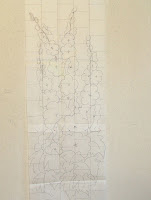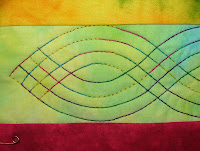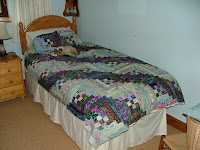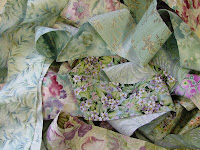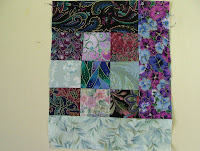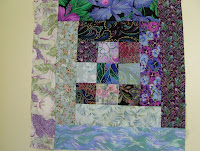Space is available in my studio (2/3rds of a double garage) but time is difficult. Currently we have 2 brown Labradors in residence whilst my daughter and husband enjoy a sunshine break. The cats aren’t impressed and have gone to live up the corridor. The dogs have boundless energy and this is dissipated in and around our large garden and paddock. They are enthusiastic gardeners but not very good at it! They had their own visitors yesterday! What do you call a collection of Labradors? A tumble, a lick, a blur, no I like a frolick of Labradors.
I have made significant progress too on the Gresford sampler and quilted the following blocks:
Dresden Plate
Inner City
Tumbling Block
You may have noticed that I don’t work on one project at a time; I’m not wired to do that. I need variety and a sense of panic to function properly. So as well as all the other stuff going on I have one of my painterly wall hangings in progress. I am very influenced by what is going on around me in the garden and, although I have no hollyhocks in my own, I have friends who do.
Hollyhocks: Start with a Master Pattern. This is loosely drawn on a sheet of baking parchment, divided in a staggered vertical grid.
Hollyhocks pattern
Fabrics are selected from my stash to make the wall hanging and prepared with Bondaweb. I use a fluted rotary cutter to divide the bonded fabrics into strips.
Hollyhocks fabrics
Squares are prepared on a separate sheet of baking parchment and pinned onto the Master Pattern. I have a good idea when I start of what I want to achieve and I particularly like using the strips on the diagonal.
Placing the squares
Auditioning fabrics
As I work on the background squares, I continue to audition potential fabrics by pinning them along side the Master Pattern. As this is a visual and intuitive process, I need to continually assess my progress from a distance. To do this, I stand with my back to my work and look over my shoulder through a mirror. This doubles the distance in my studio and allows me to see where the problems are.



